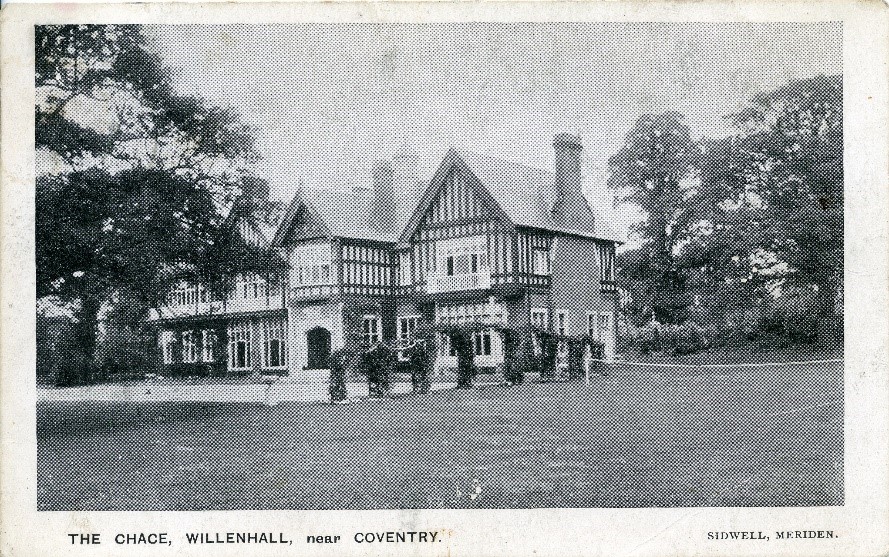CovSoc member John Marshall reflects on the history of the Chace Hotel and offers some personal reminiscences

Work has begun on the transformation of an historic Coventry building which served the city for many years as an imposing and illustrious hotel.
The Chace Hotel on London Road finally closed its doors in December last year and is now being turned into a care home, offering “bespoke care home accommodation for those with mental health care needs”.
A last ditch effort in 2018-19 to revive the fortunes of the old hotel – by re-branding the building as a Laura Ashley hotel and offering boutique rooms and afternoon teas – was ultimately unsuccessful.
The building, formerly owned by Corus Hotels, was acquired by the Fairhome Property Group PLC and the new care home facility will be run by the ‘Rethink Mental Illness’ charity. Under the plans, the existing main building will remain intact but a 1970s extension at the side of the property will be replaced.
The Chace was first built between 1897 and 1903 as an opulent country residence for Dr Charles Webb Iliffe, a prominent figure in the local community who worked for 40 years as coroner for Coventry and North Warwickshire. He also sat on the Poor Law Board of Guardians and served for 37 years as medical officer to Coventry Workhouse. In later life he ceased medical practice but remained active in municipal life, becoming a city councillor and a JP. He was also known as an entertaining after-dinner speaker.

Dr Iliffe was in his late 50s when he moved, with his wife Annie, to the rural isolation of Willenhall, then little more than a tiny hamlet. The Chace was built in the form of a large country manor, in half-timbered, gabled style, looking gently down towards the nearby River Sowe and situated close to the old turnpike road to London. The house had an elegant sweeping staircase and exquisite Edwardian rooms.
By the time of Iliffe’s death, in 1921, his principal residence had moved to The Woodlands in Kenilworth Road, and by 1930 his fomer home in Willenhall had been sold. It was purchased by Gertrude Patience Williams and a Mr Hartop of Leicester, who turned the building into an independent hotel.
The new owners were keen to extend the property and in April 1932 an application was made to Foleshill Rural District Council to add a lengthy extension, facing London Road. The application was approved in April, by which time the area had become part of Coventry, following the boundary changes of that year. The new flank was built in red brick with
Tudor style timber work, akin to the original building. It is this London Road frontage that would come to dominate the image of the Chace Hotel for the next 80 years.

Life at the Chace Hotel in the 1950s was deeply traditional, with a rigid hierarchy and strict rules of etiquette. My own mother worked there during this period, as a lowly laundry assistant, and my earliest boyhood memories relate to The Chace, and the sprawling acres of the new Willenhall estate.
Like many other families in post-war Coventry, we lived in a prefab, initially built as temporary accommodation and having the advantage of being simple, functional and cheap. There were hundreds of prefabs all over Coventry – not just Willenhall – and these took their place within a landscape of war-time workers’ hostels and bright new council estates.


I lived within a single-parent family, with my slightly older sister, Dianne, and my mother, Jean, who had to struggle constantly to make ends meet. Mother’s job in the laundry at the Chace Hotel was almost certainly low paid and was hard work, with few labour-saving devices.
The laundry was hidden away inside a large, barn-like garage, where the hotel owner, presumably Mr Hartop, kept his sporty green car. It’s tempting to use the term “Dickensian” to describe the laundry, but this might not be entirely accurate. But the equipment and conditions were certainly primitive when compared to modern facilities. There were large rectangular sinks with brass taps, copper boilers, huge mangles and long rollers to iron the sheets. There was also a series of racks where sheets could be hung and then raised to the ceiling with pulleys, to dry. The space available to the women workers was small and the conditions were often hot.

The Chace in those days had gardens at the rear of the building where vegetables were grown, out of sight of the guests. There was also a large greenhouse and a pig sty. A young gardener called Paul, who limped around with an iron brace on his leg – probably caused by polio – was happy to show me around and I particularly remember a huge tub of pigswill – waste food from the hotel – being brought to the pig sty and slushed into containers for the animals to eat. It was an early glimpse of The Good Life, but without Barbara and Tom.
We left Willenhall – and the grind of the Chace Hotel laundry – in 1961 when mum married a good man from Warwick and we moved there, with a change of school, a change of house and a change of surname to boot. I was eight years old and there was everything to play for. But that, as they say, is another story.
Old photographs courtesy of Willenhall Local History Group and David Fry. This article first appeared in the August 2022 edition of the Stoke Local History Group Newsletter.
